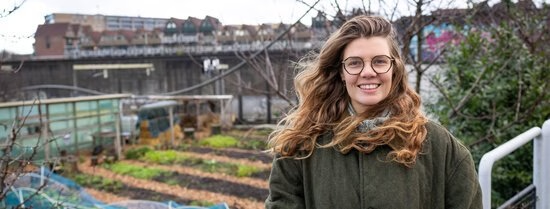The medium of film plays a vital role in the research of PhD researcher Renate Schelwald, which focuses on what is needed to create and maintain a sustainable food environment. During her master's in visual anthropology, she discovered how to combine her passion for film with academic research. "It is fantastic that film as a medium is accepted as a form of research in this field. This really opened up a whole new world for me."
At Erasmus School of Social and Behavioural Sciences, Renate researches how food practices, such as cooking, eating and shopping, contribute to greenhouse gas emissions and how these practices can become more sustainable. Sustainable food practices are about technical or behavioural adjustments and the relationships between people, food and the land. Renate approaches it holistically, investigating the relationship between people, food and the land. Rather than focusing solely on individual behaviour, her research focuses on a systemic approach to sustainability, in which communities and their connection to nature are central.

More nuance through visual ethnography
Renate uses visual ethnography to study these food environments, communities, and social interactions. This research method uses visual media – such as photography and film – to make complex subjects accessible and actively involve the viewer. By not only relying on textual data or numbers, you can use visual media to provide a more nuanced picture. “Visual ethnography provides a picture of reality, allowing viewers better to understand the feelings and experiences behind the facts,” Renate explains.
Visual ethnographic research is data intensive
Using visual ethnography as a research method can sometimes be challenging. In the early stages of Renate’s project, she was often asked whether she could increase the number of participants in her research. “This type of question highlights a common misunderstanding: ethnographic research, especially visual ethnographic research, is not meant to be representative but rather focuses on the depth of the insights gained. It is not about collecting quantitative data, but about obtaining detailed and contextual information by intensively following a small group of participants over a longer period.”
She adds that using visual methods adds an extra layer of complexity to the process, as it is time-consuming and data intensive. It allows the researcher to add more nuance and richness to the research. However, another challenge is that the university’s systems do not handle such large amounts of qualitative data. “For example, uploading all my data to Yoda, the university’s digital system, was practically impossible. I purchased an external hard drive with encryption to store and transport my data safely.”

Co-creation and community involvement
In the research, Renate actively involves local communities through co-creation. By recording images together with these communities, you are not only observing them, but you can also make them an active part of the research. For example, by filming activities in food gardens, participants are allowed to share their perspectives in an accessible way. “Film is not only a means of collecting data but also an instrument to give communities a voice,” says Renate.
From passive spectators to active participants
Using film in research makes citizens active participants instead of passive spectators. This is partly because the participants actively share their stories, influencing policy. One of the main characters in a film told how she struggled to realize a more sustainable food system in her neighborhood and suggested how the municipality could help them set up a communal food garden. Renate says, " This process of filming and conversation gives the participants more control over how their story is presented. You notice that participants like this idea.”
Reach a wider audience
The images that Renate collects are used to share her findings with a wider audience, such as policymakers and other residents. "Film is a powerful tool to convey emotions, making it easier to engage policymakers and residents and stimulate change," says Renate. As a research method, film helps to communicate things that are difficult to express in text, such as interactions or daily rituals. "Images not only show the physical space but also the emotional and social interaction within communities," says Renate. It gives policymakers insight into sustainability's cultural and emotional dimensions, allowing them to think beyond technical solutions.

Policymakers respond positively to visual ethnography
Renate says that so far, she has had positive experiences using film as a presentation for policymakers. Since reports are often long and complex, keeping people interested during a long-term research project is quite a challenge. Film helps to present results in a lively and transparent way, often with much more information in a shorter time. Renate remembers a specific moment:
“During the presentation of a 90-page report, we showed audiovisual work. The presentation was intended for the policy makers who had funded the research and with whom we worked together to get sustainable interventions off the ground. Toward the end of the 5-minute video, starring one of the research participants working in a community garden, one of the policy advisors promptly opened his laptop and started fiddling around with it. The research team looked at him in surprise after the video had ended and exclaimed: ‘I’m already looking for plots! This doesn’t seem that difficult to organize?’.
- PhD student
- More information
This interview is part of Spark. With these interviews, we aim to draw attention to the positive impact of the faculty's education and research on society. The stories in Spark give an insight into what makes ESSB students, alumni, staff and researchers tick.
Contact: Britt van Sloun, redactie en communicatie ESSB, vansloun@essb.eur.nl

